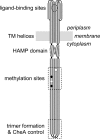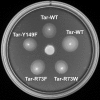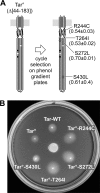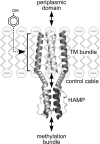Phenol sensing by Escherichia coli chemoreceptors: a nonclassical mechanism
- PMID: 21965561
- PMCID: PMC3232889
- DOI: 10.1128/JB.05987-11
Phenol sensing by Escherichia coli chemoreceptors: a nonclassical mechanism
Abstract
The four transmembrane chemoreceptors of Escherichia coli sense phenol as either an attractant (Tar) or a repellent (Tap, Trg, and Tsr). In this study, we investigated the Tar determinants that mediate its attractant response to phenol and the Tsr determinants that mediate its repellent response to phenol. Tar molecules with lesions in the aspartate-binding pocket of the periplasmic domain, with a foreign periplasmic domain (from Tsr or from several Pseudomonas chemoreceptors), or lacking nearly the entire periplasmic domain still mediated attractant responses to phenol. Similarly, Tar molecules with the cytoplasmic methylation and kinase control domains of Tsr still sensed phenol as an attractant. Additional hybrid receptors with signaling elements from both Tar and Tsr indicated that the transmembrane (TM) helices and HAMP domain determined the sign of the phenol-sensing response. Several amino acid replacements in the HAMP domain of Tsr, particularly attractant-mimic signaling lesions at residue E248, converted Tsr to an attractant sensor of phenol. These findings suggest that phenol may elicit chemotactic responses by diffusing into the cytoplasmic membrane and perturbing the structural stability or position of the TM bundle helices, in conjunction with structural input from the HAMP domain. We conclude that behavioral responses to phenol, and perhaps to temperature, cytoplasmic pH, and glycerol, as well, occur through a general sensing mechanism in chemoreceptors that detects changes in the structural stability or dynamic behavior of a receptor signaling element. The structurally sensitive target for phenol is probably the TM bundle, but other behaviors could target other receptor elements.
Figures








Similar articles
-
Conformational suppression of inter-receptor signaling defects.Proc Natl Acad Sci U S A. 2006 Jun 13;103(24):9292-7. doi: 10.1073/pnas.0602135103. Epub 2006 Jun 2. Proc Natl Acad Sci U S A. 2006. PMID: 16751275 Free PMC article.
-
Repellent response functions of the Trg and Tap chemoreceptors of Escherichia coli.J Bacteriol. 1990 Jan;172(1):383-8. doi: 10.1128/jb.172.1.383-388.1990. J Bacteriol. 1990. PMID: 2403544 Free PMC article.
-
A Trigger Residue for Transmembrane Signaling in the Escherichia coli Serine Chemoreceptor.J Bacteriol. 2015 Aug 1;197(15):2568-79. doi: 10.1128/JB.00274-15. Epub 2015 May 26. J Bacteriol. 2015. PMID: 26013490 Free PMC article.
-
Signaling and sensory adaptation in Escherichia coli chemoreceptors: 2015 update.Trends Microbiol. 2015 May;23(5):257-66. doi: 10.1016/j.tim.2015.03.003. Epub 2015 Mar 30. Trends Microbiol. 2015. PMID: 25834953 Free PMC article. Review.
-
Bacterial chemoreceptors: recent progress in structure and function.Mol Cells. 1999 Apr 30;9(2):115-8. Mol Cells. 1999. PMID: 10340463 Review.
Cited by
-
The role of solute binding proteins in signal transduction.Comput Struct Biotechnol J. 2021 Mar 26;19:1786-1805. doi: 10.1016/j.csbj.2021.03.029. eCollection 2021. Comput Struct Biotechnol J. 2021. PMID: 33897981 Free PMC article. Review.
-
Discovery of a New Chemoeffector for Escherichia coli Chemoreceptor Tsr and Identification of a Molecular Mechanism of Repellent Sensing.ACS Bio Med Chem Au. 2022 Mar 18;2(4):386-394. doi: 10.1021/acsbiomedchemau.1c00055. eCollection 2022 Aug 17. ACS Bio Med Chem Au. 2022. PMID: 37102165 Free PMC article.
-
An atlas of metabolites driving chemotaxis in prokaryotes.Nat Commun. 2025 Feb 1;16(1):1242. doi: 10.1038/s41467-025-56410-y. Nat Commun. 2025. PMID: 39890791 Free PMC article.
-
Biotoxin detection using cell-based sensors.Toxins (Basel). 2013 Nov 29;5(12):2366-83. doi: 10.3390/toxins5122366. Toxins (Basel). 2013. PMID: 24335754 Free PMC article. Review.
-
Sensory Repertoire of Bacterial Chemoreceptors.Microbiol Mol Biol Rev. 2017 Oct 25;81(4):e00033-17. doi: 10.1128/MMBR.00033-17. Print 2017 Dec. Microbiol Mol Biol Rev. 2017. PMID: 29070658 Free PMC article. Review.
References
-
- Adler J. 1973. A method for measuring chemotaxis and use of the method to determine optimum conditions for chemotaxis by Escherichia coli. J. Gen. Microbiol. 74:77–91 - PubMed
Publication types
MeSH terms
Substances
Grants and funding
LinkOut - more resources
Full Text Sources
Other Literature Sources
Miscellaneous

